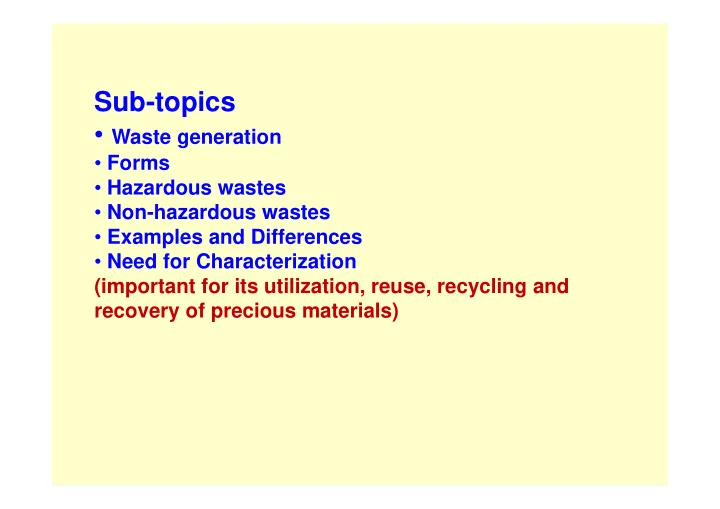

Sub-topics • Waste generation • Forms • Hazardous wastes • Non-hazardous wastes • Examples and Differences • Need for Characterization (important for its utilization, reuse, recycling and recovery of precious materials)
Waste Generation • Depends on the source of generation • May degrade into harmless products • May be: non-degradable & hazardous (and may have cumulative detrimental effects) • Solid • Liquid •Sludges • Gases • Combination of all these forms
Definitions Several definitions and Interpretations United Nations Environment Programme (UNEP) “ wastes other than radioactive wastes, which by reason of their chemical reactivity or toxic, explosive, corrosive or other characteristics causing danger or likely to cause danger to health or the environment, whether alone or coming into contact with other wastes, are legally defined hazardous in the state in which they are generated or in which they are disposed of or through which they are transported”.
Materials which are: inherently dangerous to the human body or to animals, including, but not limited to, materials that are toxic/poisonous Irritants strong sensitizers Flammable explosive (i.e., generate power through decomposition, heat or other means) infectious (i.e., represent a potential source for transmission of disease to humans, domestic animals or wildlife) radioactive (i.e., containing sufficient radioactivity) pesticides
wastes from commercial or trade companies, which, due to their nature, composition or quantities, are especially hazardous to human health, air or water, or are explosive, flammable or may cause diseases”. Hazardous wastes are those wastes which due to their nature and quantity are potentially hazardous to human health and/or the environment, and require special disposal techniques to eliminate or reduce the hazard. one that may cause or significantly contribute to serious illness or death or that poses a substantial threat to human health or the environment when improperly managed waste is any substance for which the owner/generator has no further use and which is discarded.
Types of the WASTE NON-HAZARDOUS WASTE HAZARDOUS WASTE
Types of the WASTE NON-HAZARDOUS WASTE HAZARDOUS WASTE Industrial Municipal Industrial Non-hazardous Resource Conservation & Recovery Act (RCRA)
Municipal Waste Compost Scrap tires Used oil Sewage sludge Water treatment sludge
Industrial Non-Hazardous Waste Coal ash (fly ash /Bottom ash) Ferrous & non-ferrous slags Reclaimed paving materials Construction & Demolition debris Cement & lime kiln dusts Sulphates Foundary, Cermaic, Silica fumes Dredged material (too much volume, disposal problems) Minerals waste rocks mill tailings coal refuse washery rejects phosphogypsum Agricultural Animal manure Crop wood Organic & Liquid wastes Solid waste combustion residues Reclaimed plastic Waste glass
Disposal of Industrial Non-Hazardous Waste Land disposal Ocean disposal Incineration (reduces the wt. of the waste, ash production) Sewer disposal Septic tanks Lagoons/surface impoundments Construction applications Resource recovery
HAZARDOUS WASTE (source USEPA) www.epa.gov ( U.S. Environmental Protection Agency) Major source is Industrial activity Poses significant threat to the environment/health In combination with other materials or alone Four types (EPA, 1980) Type 1 Aqueous-Inorganic Type 2 Aqueous-Organic Type 3 Organic Type 4 Hazardous sludges, slurries & solids
HAZARDOUS WASTE Major source is Industrial activity Poses significant threat to the environment/health In combination with other materials or alone Hazard associated with the waste is not only due to its presence but also due to its concentration Hazardous material in a very dilute form may be harmless, even though in its concentrated form it may be very toxic. As such, detection of a “Hazardous material” in the ground does not necessarily indicate a significant problem
Sources of Hazardous Waste Nuclear Power Plants Municipal Solid Waste (MSW) Landfills Chemical and Primary Metal Industries Paint and Dye Manufacturing Industries Mining Industries Paper and Pulp Industries Battery, Fuel cell industry Leather industry Electroplating Textile industries Hospitals and pharmaceutical companies
Examples Non-biodegradable Synthetic Organics Heavy Metal (Chlorinated Hydrocarbons) Dioxin (A chemical which causes cancer, Lead especially breast cancer, the combination of fat, high heat, and plastics releases dioxin) Mercury DDT Arsenic Kepone Cadmium Mirex Tin PCB's Zinc Carbon Tetrachloride Chromium Benzene Copper Chloroform Beryllium Polyvinyl Chlorides Strontium
Recommend
More recommend